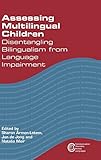Assessing Multilingual Children : Disentangling Bilingualism from Language Impairment / ed. by Sharon Armon-Lotem, Jan de Jong, Natalia Meir.
Material type: TextSeries: Communication Disorders Across LanguagesPublisher: Bristol ; Blue Ridge Summit : Multilingual Matters, [2015]Copyright date: ©2015Description: 1 online resourceContent type:
TextSeries: Communication Disorders Across LanguagesPublisher: Bristol ; Blue Ridge Summit : Multilingual Matters, [2015]Copyright date: ©2015Description: 1 online resourceContent type: - 9781783093120
- 9781783093137
- Language disorders in children -- Diagnosis
- Multilingualism in children
- LANGUAGE ARTS & DISCIPLINES / Linguistics / General
- Bilingualism
- Child Language Disorders
- Communication disorders
- Language Assessment
- Language development in bilingual children
- SLI
- Specific language Impairment
- Speech and Language Disorders
- developmental disorder
- language impairment
- 618.92/855 23
- RJ496.L35 A84 2015
- RJ496.L35
- online - DeGruyter
- Issued also in print.
| Item type | Current library | Call number | URL | Status | Notes | Barcode | |
|---|---|---|---|---|---|---|---|
 eBook
eBook
|
Biblioteca "Angelicum" Pont. Univ. S.Tommaso d'Aquino Nuvola online | online - DeGruyter (Browse shelf(Opens below)) | Online access | Not for loan (Accesso limitato) | Accesso per gli utenti autorizzati / Access for authorized users | (dgr)9781783093137 |
Frontmatter -- Contents -- Contributors -- Introduction -- Part 1 Syntax and Its Interfaces -- 1 .Elicitation Task for Subject- Verb Agreement -- 2 .Contrastive Elicitation Task for Testing Case Marking -- 3. Elicited Production of Object Clitics -- 4. Comprehension of Exhaustive Wh-Questions -- 5. Sentence Repetition -- Part 2 Phonological and Lexical Processing -- 6. Non-Word Repetition -- 7. Using Parental Report to Assess Early Lexical Production in Children Exposed to More Than One Language -- 8 .Designing Cross-Linguistic Lexical Tasks (CLTs) for Bilingual Preschool Children -- Part 3 Beyond Modality -- 9 .Assessment of Narrative Abilities in Bilingual Children -- 10. Executive Functions in the Assessment of Bilingual Children with Language Impairment -- Part 4 From Theory to Practice -- 11. Clinical Use of Parental Questionnaires in Multilingual Contexts -- 12. Proposed Diagnostic Procedures for Use in Bilingual and Cross-Linguistic Contexts -- Language Index -- Subject Index
restricted access online access with authorization star
http://purl.org/coar/access_right/c_16ec
Second language learners often produce language forms resembling those of children with Specific Language Impairment (SLI). At present, professionals working in language assessment and education have only limited diagnostic instruments to distinguish language impaired migrant children from those who will eventually catch up with their monolingual peers. This book presents a comprehensive set of tools for assessing the linguistic abilities of bilingual children. It aims to disentangle effects of bilingualism from those of SLI, making use of both models of bilingualism and models of language impairment. The book's methods-oriented focus will make it an essential handbook for practitioners who look for measures which could be adapted to a variety of languages in diverse communities, as well as academic researchers.
Issued also in print.
Mode of access: Internet via World Wide Web.
In English.
Description based on online resource; title from PDF title page (publisher's Web site, viewed 24. Apr 2022)


